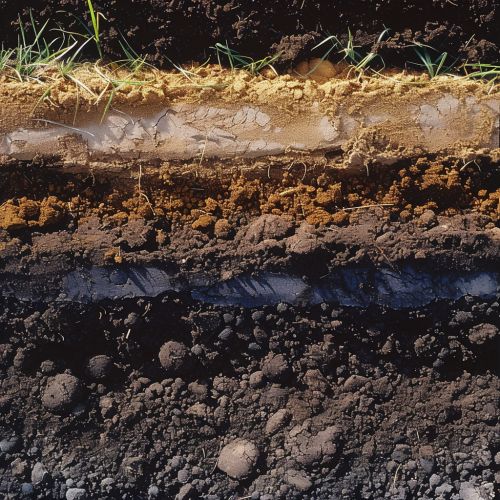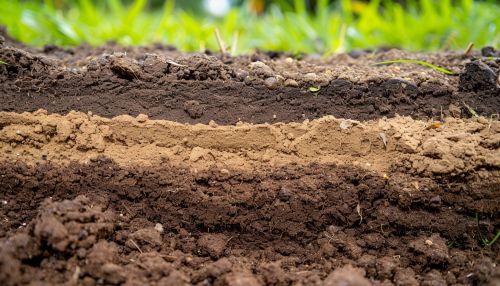Soil Leaching
Introduction
Soil leaching is a process by which water-soluble substances are washed out from the soil. This phenomenon is a crucial aspect of soil chemistry and environmental science, affecting nutrient availability, soil fertility, and groundwater quality. Leaching can occur naturally through rainfall or artificially through irrigation. The substances leached from the soil can include nutrients, pesticides, and contaminants, which may have significant ecological and agricultural implications.
Mechanism of Soil Leaching
Soil leaching primarily involves the downward movement of water through the soil profile. As water percolates through the soil, it dissolves and carries away soluble substances. The rate and extent of leaching depend on several factors, including soil texture, structure, organic matter content, and the chemical properties of the substances involved.
Soil Texture and Structure
Soil texture, defined by the proportion of sand, silt, and clay particles, significantly influences leaching. Sandy soils, with larger pore spaces, allow for rapid water movement and higher leaching rates. Conversely, clayey soils, with smaller pore spaces, slow down water movement, reducing leaching. Soil structure, the arrangement of soil particles into aggregates, also affects water infiltration and leaching. Well-aggregated soils with good porosity facilitate water movement, while compacted soils hinder it.


Organic Matter Content
Organic matter in the soil can bind to nutrients and contaminants, reducing their solubility and mobility. High organic matter content can thus decrease leaching by retaining substances within the soil matrix. Additionally, organic matter improves soil structure, enhancing water infiltration and retention.
Chemical Properties of Substances
The chemical properties of the substances being leached, such as solubility, charge, and molecular size, play a crucial role in their mobility. Highly soluble substances, like nitrates, are more prone to leaching compared to less soluble substances, like phosphates. The charge of ions also affects their interaction with soil particles; for instance, positively charged cations may be adsorbed onto negatively charged clay particles, reducing their leaching potential.
Factors Influencing Soil Leaching
Several environmental and anthropogenic factors influence soil leaching, including precipitation, irrigation practices, land use, and soil management.
Precipitation
Rainfall is a primary driver of natural leaching processes. High precipitation rates can lead to increased leaching, especially in regions with permeable soils. Seasonal variations in rainfall also affect leaching patterns, with more leaching occurring during wet seasons.
Irrigation Practices
Irrigation, particularly in agricultural settings, can significantly impact leaching. Over-irrigation or improper irrigation practices can lead to excessive leaching of nutrients and contaminants. Efficient irrigation methods, such as drip irrigation, can minimize leaching by delivering water directly to the root zone, reducing percolation losses.
Land Use and Soil Management
Land use changes, such as deforestation, urbanization, and agricultural expansion, can alter soil properties and leaching dynamics. Soil management practices, including tillage, crop rotation, and the application of fertilizers and pesticides, also influence leaching. For example, excessive use of nitrogen fertilizers can lead to nitrate leaching, contaminating groundwater supplies.
Environmental and Agricultural Implications
Soil leaching has significant implications for both the environment and agriculture. The loss of essential nutrients through leaching can reduce soil fertility, affecting crop yields and agricultural productivity. On the other hand, leaching of contaminants, such as pesticides and heavy metals, can pollute groundwater and surface water bodies, posing risks to human health and ecosystems.
Nutrient Leaching
Nutrient leaching, particularly of nitrogen and potassium, is a major concern in agriculture. Nitrate leaching, for instance, can lead to the depletion of soil nitrogen, necessitating additional fertilizer inputs. This not only increases production costs but also contributes to environmental pollution. Phosphorus leaching, though less common, can lead to eutrophication of water bodies, causing algal blooms and oxygen depletion.
Contaminant Leaching
The leaching of contaminants, including pesticides, herbicides, and heavy metals, can have severe environmental consequences. These substances can contaminate groundwater, making it unsafe for drinking and irrigation. Additionally, they can accumulate in the food chain, affecting wildlife and human health. Effective soil and water management practices are essential to mitigate the risks associated with contaminant leaching.
Mitigation Strategies
Several strategies can be employed to reduce soil leaching and its adverse effects. These include improving soil structure, optimizing irrigation practices, and adopting sustainable land management techniques.
Soil Structure Improvement
Enhancing soil structure through the addition of organic matter, such as compost or manure, can reduce leaching by improving water retention and nutrient binding. Cover cropping and reduced tillage practices can also enhance soil structure and reduce erosion, further minimizing leaching.
Optimized Irrigation Practices
Efficient irrigation methods, such as drip irrigation and scheduling based on soil moisture levels, can reduce water percolation and leaching. Precision agriculture techniques, which involve the use of sensors and data analytics, can optimize water and nutrient application, minimizing losses.
Sustainable Land Management
Adopting sustainable land management practices, such as crop rotation, intercropping, and agroforestry, can enhance soil health and reduce leaching. These practices promote biodiversity, improve soil structure, and increase organic matter content, all of which contribute to reduced leaching.
Conclusion
Soil leaching is a complex process influenced by various factors, including soil properties, environmental conditions, and human activities. Understanding the mechanisms and implications of leaching is essential for effective soil and water management. By adopting sustainable practices and optimizing resource use, it is possible to mitigate the adverse effects of leaching, ensuring soil fertility and environmental health.
